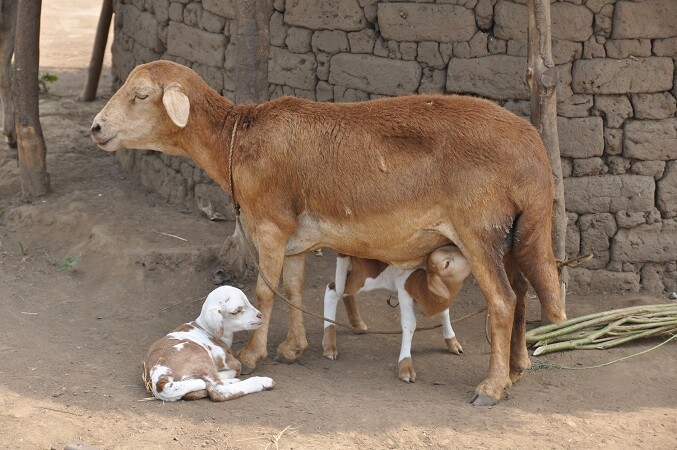

Sheep need dry climate. It has no problem with low temperatures during the rainy season. But the relative humidity in the rainy season should not be high. Hence low rainfall area is good for sheep farming. Hilly forest areas and the coastal regions are not suitable for sheep farming. Even in medium rainfall area the problem of worms and diseases are more.
Apart from suitable climate, sufficient land and water to grow green fodder is necessary. If one can get 3 crops of fodder in a year, two acre is enough for 40 to 45 sheep and their lambs.
Housing for sheep
Goats likes to stay at height above the ground. But sheep are happy to stay on the ground. A shed is necessary to shelter the sheep during the rainy season and at night. Go for low cost or systematic high cost shed depending upon your investment capacity. Cross ventilation and light penetration is most important in the sheep shed. Open paddock next to the shed is important. Keeping the sheep here at least for few hours daily is a must. Sheep are kept inside the shed only during night hours. Each adult sheep needs 10 square feet area. Shed and the paddock should all be covered by a wire mesh fence of sufficient height to prevent the sheep from jumping out. Keeping trees around the farm is recommended to keep the atmosphere cool.
Pregnant ewes, lambs and rams are kept in separate groups based on sex, age and body weight. This is necessary to provide feed-fodder and medicine in required quantity and time. Wire mesh or wooden partitions are made for this purpose. Using mud for the floor is better because it absorbs the urine minimizing ammonia smell. This is important for the overall good health of the sheep. You can also use burnt mud bricks may be used for flooring for easy maintenance but cement floor is not advisable. Sheep regularly lying on cement floors gets bed sores.
Distributing the feed and fodder in a big herd is a difficult task. Feeders are useful for this purpose. It may be of wood or metal sheets. One feeder for 15 to 20 sheep is necessary to avoid competition. Water troughs of GI sheet are kept for drinking water. Plastic coated metal troughs are still better. Clean the feeders and water troughs once in a day. Motored and manual chaff cutters are the other necessary equipment.
Sheep breeding
Ewes attain maturity by 12 to 14 months and the rams by 10 to 12 months. Keep one ram for 20 to 25 ewes. Rams and ewes are kept in separate groups. Send the selected ram in to the herd of ewes ready for mating. Ewe comes in to oestrus after 2 months of lambing. We can expect 3 lambing in 2 years under good management. Normally ewe delivers only one lamb per lambing. 2 lambs are very rare.
Ewe selected for breeding for the first time should be in 2 teeth stage. That is at 1-month age. The minimum body weight must be at least 20 to 22 kilograms. Do not use under- weight ewes. Select 100 ewes for breeding in the beginning. Retain 60 to 70 % of them for further breeding based on the desired characteristics after first lambing. Cull out the remaining ones. The ram selected for breeding should have 30 to 35 kilograms of body weight by 2 teeth stage. Growth of both the testicles must be uniform. Ram should be healthy, active and standing like a horse on straight and strong legs. Avoid rams and ewes with any sexual disease. Ewes can be retained for breeding for 5 to 6 years. They are culled out early in developed countries. Ewes produce weak lambs and suffer with debility at old age.
Inbreeding is the major problem of sheep farming. Due to this local breeds in traditional farming are suffering with stunted growth and many other health problems. Hence put tags to each ram and maintain its ancestry records. Change the ram in each breeding season. If the farm has more than one group of breeding ewes, ram may be shifted to another group in the next season. Here we can retain the ram for one more season. Later on buy or exchange the new ram from a distant farm without blood relation with ewes. Avoiding inbreeding is most important for the success of sheep farming.
 Contact Jaguza Support
Contact Jaguza Support